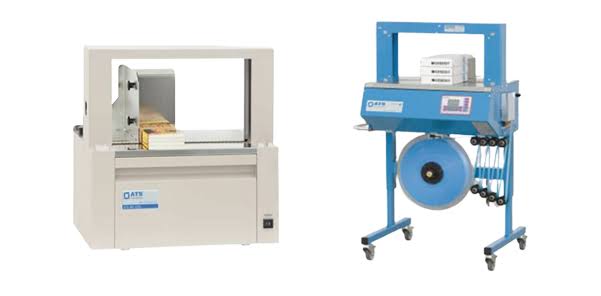The Role of Banding Machines in Packaging and Securing Products


In the world of modern manufacturing and packaging, the efficient and secure bundling of products is a crucial aspect of the production process. Banding machines, also known as strapping machines, play an indispensable role in ensuring that items are neatly and securely packaged. These machines are used across a variety of industries and applications, from securing boxes in a warehouse to bundling printed materials in a printing shop. In this comprehensive article, we’ll delve deeper into the key functions, benefits, and applications of banding machines in the realm of packaging and product securing.
Understanding Banding Machines
Banding machines are specialized equipment designed to apply straps, bands, or belts made from materials such as plastic, polyester, steel, or paper around products or packages. The primary objective of banding is to secure, stabilize, and bundle items, making them easier to handle, transport, and store. These machines are capable of precisely tensioning and sealing the bands to maintain product integrity.
Key Functions of Banding Machines
- Product Bundling: One of the primary functions of banding machines is to bundle together products, typically within the same package. This is essential for organizing and securing items, whether they are printed materials, boxes of products, newspapers, or even fruits and vegetables.
- Tensioning: Banding machines can apply the appropriate tension to the bands, ensuring that products are held securely without being damaged. The adjustable tension settings allow for flexibility in securing various types of items.
- Sealing: Once the bands are applied and tensioned, the banding machine seals them. This seal can be created through various methods, including heat sealing, ultrasonic sealing, or friction welding, depending on the type of banding machine used.
- Cutting: Many banding machines are equipped with a cutting mechanism that trims excess banding material, creating a neat and tidy finish.
- Labeling: Some banding machines can also incorporate labeling capabilities, enabling the application of product information or branding labels during the banding process.
Benefits of Banding Machines
- Efficiency: Banding machines are exceptionally efficient, capable of quickly and consistently applying bands to products. This efficiency can lead to significant time and labor savings in production and packaging operations.
- Cost-Effective: Compared to other packaging methods, banding is often a cost-effective solution. The materials used are typically less expensive than traditional packaging materials like cardboard boxes, and banding machines require minimal maintenance.
- Product Protection: Banding provides a secure yet gentle means of bundling products, ensuring they are held together without causing damage. This is particularly important for delicate or fragile items.
- Eco-Friendly: Many banding materials, such as paper and certain plastics, are recyclable, making banding a sustainable packaging solution.
- Customization: Banding machines offer the flexibility to customize the banding process, accommodating different product sizes, shapes, and materials.
- Increased Brand Visibility: In addition to securing products, banding machines can be equipped with labeling capabilities to apply branded or product information labels. This enhances brand visibility and recognition.
- Ease of Handling: Bundled products are easier to handle and transport, reducing the risk of accidents and injuries during the movement of goods.
- Space Efficiency: Banding is particularly space-efficient, as it allows for neat stacking and storage of bundled products, saving valuable storage space in warehouses.
Applications of Banding Machines
- Printing Industry: Banding machines are widely used in the printing industry to bundle newspapers, magazines, brochures, and printed materials. They are particularly effective in securing large stacks of paper, ensuring that publications maintain their pristine condition during transportation and handling.
- Food Industry: In the food industry, banding machines are employed for bundling fruits and vegetables, as well as baked goods. Whether it’s bundling a stack of produce for retail display or securing bread loaves, banding ensures product freshness and attractiveness while simplifying handling.
- Manufacturing: In manufacturing, banding machines are used to secure and bundle products in various industries, including electronics, cosmetics, and pharmaceuticals. Whether bundling cables, cosmetic products, or pharmaceutical supplies, banding ensures that products are held securely in place.
- Warehousing and Distribution: Banding machines are utilized in warehousing and distribution centers to secure packages and reduce the risk of product damage during transportation. From corrugated boxes to bulky items, banding simplifies handling and protects the integrity of products.
- Construction: In the construction industry, banding machines are used to secure bundles of construction materials, such as pipes, tubes, and wooden planks. These machines simplify transportation, safeguard products, and enhance workplace safety by preventing loose materials from shifting during transit.
- Graphic Arts: Beyond the printing industry, banding machines find applications in graphic arts for bundling and securing materials like posters, banners, and artwork. The tight and secure bundling ensures that these materials remain pristine and ready for display.
- Timber Industry: The timber and wood processing sector also benefits from banding machines. They are used to secure and bundle timber products, ensuring safe transport and storage.
- Pharmaceuticals: In pharmaceutical manufacturing, banding machines are essential for bundling boxes of medicines and medical supplies. The precision and product protection they offer are critical in the pharmaceutical industry.
The Future of Banding Machines
As technology continues to advance, banding machines are evolving to offer even greater efficiency and versatility. These machines are increasingly equipped with automation and integration features, allowing for seamless operation within modern production and packaging lines. Additionally, the development of biodegradable and sustainable banding materials is contributing to environmentally friendly packaging solutions, aligning with the growing emphasis on sustainability and eco-conscious practices in the packaging industry.
Automation in banding machines is becoming more sophisticated, allowing for precise and rapid banding of products. Integration with conveyor systems and other machinery enables a seamless production and packaging process.
Environmental Considerations
One of the notable trends in the banding industry is the development of sustainable banding materials. As environmental consciousness grows, manufacturers and packaging companies are seeking eco-friendly alternatives to traditional plastic bands. Biodegradable and recyclable banding materials made from paper and plant-based plastics are gaining popularity. These materials provide an eco-conscious option for companies looking to reduce their environmental footprint.
Smart Banding Technology
Advancements in technology are also leading to smart banding solutions. These systems are equipped with sensors, automation, and connectivity, enabling precise control over the banding process. Some smart banding machines can adjust tension and band placement in real-time, ensuring optimal results. This level of precision is particularly valuable in industries like food packaging, where gentle handling and precise tension are critical.
Customization and Branding
Banding machines offer the added benefit of customization. Companies can select banding materials in various colors, widths, and textures to align with their branding and product presentation. The ability to add product information labels or branding labels during the banding process further enhances brand visibility and recognition. This customization extends to the printing on the bands themselves, allowing companies to communicate their branding and product information directly on the band.
Enhanced Durability
Advancements in banding materials have led to increased durability. Modern bands are designed to withstand various environmental conditions, ensuring that products remain secure during transit and storage. For example, steel bands offer exceptional strength and durability for heavy-duty applications, while polyester bands provide resistance to moisture and UV radiation.
Conclusion
Banding machines are an indispensable component in modern packaging and product securing processes. Their efficiency, cost-effectiveness, and product protection capabilities make them a preferred choice across a wide range of industries. Whether you’re bundling printed materials, securing food products, or streamlining manufacturing operations, banding machines offer a reliable and sustainable solution for your packaging needs.
With the ability to customize banding for various products and the added benefits of efficiency, eco-friendliness, and customization, banding machines are a valuable asset in today’s production and packaging landscape. As technology continues to advance, the role of banding machines is poised to become even more integral in the world of packaging and product securing. The trend toward sustainability, smart banding technology, and enhanced durability ensures that these machines will continue to play a critical role in modern manufacturing and packaging for years to come.





